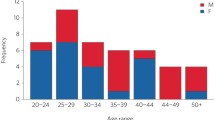Abstract
There have been a number of calls for public engagement in geoengineering in recent years. However, there has been limited discussion of why the public should have a say or what the public can be expected to contribute to geoengineering discussions. We explore how public engagement can contribute to the research, development, and governance of one branch of geoengineering, solar radiation management (SRM), in three key ways: 1. by fulfilling ethical requirements for the inclusion of affected parties in democratic decision making processes; 2. by contributing to improved dialogue and trust between scientists and the public; and 3. by ensuring that decisions about SRM research and possible deployment are informed by a broad set of societal interests, values, and framings. Finally, we argue that, despite the nascent state of many SRM technologies, the time is right for the public to participate in engagement processes.
Similar content being viewed by others
References
BPC (2011) Geoengineering: A national strategic plan for research on the potential effectiveness, feasibility, and consequences of climate remediation technologies. Bipartisan Policy Center’s Task Force on Climate Remediation
Carr W, Mercer A, Palmer C (2012) Public concerns about the ethics of solar radiation management. In: Preston CJ (ed) Engineering the climate: The ethics of solar radiation management. Lexington Books, Lahham, pp 169–186
Cooke B, Kothari U (2001) Participation: The new tyranny? Zed Books, London
Corner A, Pidgeon N (2010) Geoengineering the climate: the social and ethical implications. Environment 52(1):24–37
Corner A, Pidgeon N, Parkhill K (2012) Perceptions of geoengineering: public attitudes, stakeholder perspectives, and the challenge of ‘upstream’ engagement. Wiley Interdisc Rev Clim Chang 3(5):451–466
Crutzen P (2006) Albedo enhancement by stratospheric sulfur injections: a contribution to resolve a policy dilemma? Clim Chang 77(3):211–220
Delgado A, Lein Kjølberg K, Wickson F (2011) Public engagement coming of age: from theory to practice in STS encounters with nanotechnology. Public Underst Sci 20(6):826–845
Dryzek JS, Tucker A (2008) Deliberative innovation to different effect: consensus conferences in Denmark, France, and the United States. Public Admin Rev 68(5):864–876
European Commission (2002) Science and society: Action plan. European Commission, Luxembourg
Fiorino DJ (1990) Citizen participation and environmental risk: a survey of institutional mechanisms. Sci Tech Hum Val 15(2):226–243
Galarraga M, Szerszynski B (forthcoming) Geoengineering knowledge: interdisciplinarity and the shaping of climate engineering research. Environ Plan A
Grove-White R, Macnaghten P, Wynne B (2000) Wising up: The public and new technologies. Centre for the Study of Environmental Change, Lancaster University, Lancaster, http://www.csec.lancs.ac.uk/docs/wising_upmacnaghten.pdf
House of Commons (2010) The regulation of geoengineering. Science and Technology Committee. Fifth report of the session 2009–2010 (HC221)
House of Lords (2000) Science and society: Third report. Select Committee on Science and Technology, London
Hulme M (2010) Climate intervention schemes could be undone by geopolitics. Yale Environ 360: http://e360.yale.edu/author/Mike_Hulme/84/
IPCC (2007) Climate change 2007: The fourth assessment report of the intergovernmental panel on climate change. IPCC, Cambridge
Kearnes M, Macnaghten P, Wilsdon J (2006) Governing the nanoscale: Peoples, policies, and emerging technologies. Demos, London
Keith DW (2000) Geoengineering the climate: history and prospect. Annu Rev Energ Environ 25(1):245
Kitcher P (2001) Science, truth, and democracy. Oxford University Press, New York
Leshner AI (2003) Public engagement with science. Science 299(5609):977
Longino H (1990) Science as social knowledge: Values and objectivity in science and social inquiry. Princeton University Press, Princeton
Macnaghten P, Kearnes MB, Wynne B (2005) Nanotechnology, governance, and public deliberation: what role for the social sciences? Sci Commun 27(2):268–291
Macnaghten P, Szerszynski B (2013) Living the global social experiment: an analysis of public discourse on geoengineering and its implications for governance. Glob Environ Chang. doi:10.1016/j.gloenvcha.2012.12.008, published online 21 January 2013
Marris C, Wynne B, Simmons P, Weldon S (2001) Public perceptions of agricultural biotechnologies in Europe. Final report of the PABE Research project, http://www.lancs.ac.uk/depts/ieppp/pabe/docs.htm
Mercer AM, Keith D, Sharp JD (2011) Public understanding of solar radiation management. Environ Res Lett 6(4):044006
Moreno-Cruz J, Ricke K, Keith D (2012) A simple model to account for regional inequalities in the effectiveness of solar radiation management. Clim Chang 110(3):649–668
Olson R (2011) Geoengineering for decision makers. Woodrow Wilson International Center for Scholars, Washington, D.C
Pongratz J, Lobell DB, Cao L, Caldeira K (2012) Crop yields in a geoengineered climate. Nat Clim Chang 2(2):101–105
Preston C (2012) Solar radiation management and vulnerable populations: The moral deficit and its prospects. In: Preston CJ (ed) Engineering the climate: The ethics of solar radiation management. Lexington Books, Lanham, pp. 77–93
Rayner S, Redgewell C, Savulescu J, Pidgeon N, Kruger T (2009) Memorandum on draft principles for the conduct of geoengineering research, (the ‘Oxford Principles’) reproduced in House of Commons Science and Technology Committee, The regulation of geoengineering, fifth report of the session 2009-10, report together with formal minutes, oral and written evidence, (HC221), 18 March 2010. www.publications.parliament.uk/pa/cm200910/cmselect/cmsctech/221/221.pdf
Rayner S, Heyward C, Kruger T, Pidgeon N, Redgwell C, Savulescu J (2013) The Oxford Principles. Climatic Change. doi:10.1007/s10584-012-0675-2
Ricke KL, Morgan MG, Allen MR (2010) Regional climate response to solar-radiation management. Nat Geosci 3(8):537–541
Robock A, Oman L, Stenchikov GL (2008) Regional climate responses to geoengineering with tropical and Arctic SO2 injections. J Geophys Res: Atmospheres, 113(D16), D16101
Rowe G, Frewer LJ (2005) A typology of public engagement mechanisms. Sci Tech Hum Val 30(2):251–290
Royal Society (2004) Nanoscience and nanotechnologies: Opportunities and uncertainties. The Royal Society, London
Royal Society (2009) Geoengineering the climate: Science, governance, and uncertainty. The Royal Society, London
Rusike E (2005) Exploring food and farming futures in Zimbabwe: A citizens’ jury and scenario workshop experiment. In: Leach M, Scoones I, Wynne B (eds) Science and citizens: Globalization and the challenge of engagement. Zed Books, London
Sarewitz D, Nelson R (2008) Three rules for technological fixes. Nature 456(18):671–872
Scott D (2012) Insurance policy or technological fix? The ethical implications of framing solar radiation management. In: Preston CJ (ed) Engineering the climate: The ethics of solar radiation management. Lexington Books, Lahham, pp. 151–168
Shue H (1992) The unavoidability of justice. In: Hurrell A, Kingsbury B (eds) International politics of the environment : Actors, interests and institutions. Oxford University Press, New York, pp 373–397
SRMGI (2013) Solar radiation management: The governance of research. Environmental Defense Fund, The Royal Society, TWAS. http://www.srmgi.org/
Stilgoe J (2011) A question of intent. Nat Clim Chang 1:325–326
Stilgoe J, Wilsdon J (2007) The rules of engagement: Dialogue and democracy in creating nanotechnology futures. In: Allhoff F, Lin P, Moor J, Weckert J (eds) Nanoethics: The ethical and societal implications of nanotechnology. Wiley, Hoboken, pp 241–249
Stirling A (2005) Opening up or closing down? Analysis, participation, and power in the social appraisal of technology. In: Leach M, Scoones I, Wynne B (eds) Science and citizens: Globalization and the challenge of engagement. Zed Books, London, pp 218–231
Wilsdon J, Willis R (2004) See-through science: Why public engagement needs to move upstream. Demos, London
Wynne B (2006) Public engagement as a means of restoring public trust in science: hitting the notes but missing the music. Community Genet 9:211–220
Acknowledgments
This work was supported by the US National Science Foundation (grant number SES 0958095) and the Center for Climate and Energy Decision Making (SES-0949710), through a cooperative agreement between the National Science Foundation, Carnegie Mellon University, and the Fund for Innovative Climate and Energy Research. W.C. is funded by a US Environmental Protection Agency STAR PhD Fellowship. The authors would like to thank Maialen Galarraga, Phil Macnaghten, and the anonymous reviewers for their helpful comments on earlier drafts.
Author information
Authors and Affiliations
Corresponding author
Additional information
This article is part of a special issue on “Geoengineering Research and its Limitations” edited by Robert Wood, Stephen Gardiner, and Lauren Hartzell-Nichols.
Rights and permissions
About this article
Cite this article
Carr, W.A., Preston, C.J., Yung, L. et al. Public engagement on solar radiation management and why it needs to happen now. Climatic Change 121, 567–577 (2013). https://doi.org/10.1007/s10584-013-0763-y
Received:
Accepted:
Published:
Issue Date:
DOI: https://doi.org/10.1007/s10584-013-0763-y




